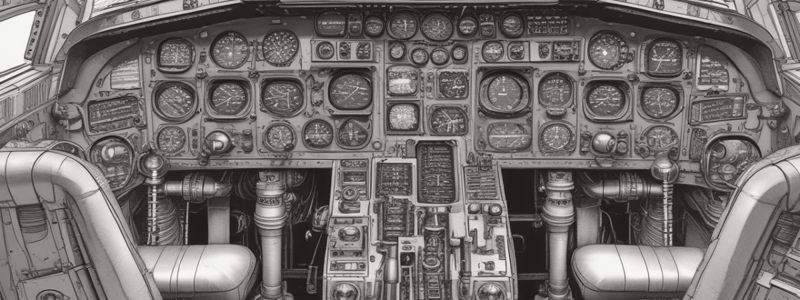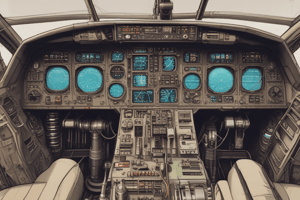Podcast
Questions and Answers
What is the nominal size of a component?
What is the nominal size of a component?
- The upper deviation of the basic size of a component
- The difference between the maximum and minimum limits of a component
- The actual size of the component as annotated in the drawing or blueprint (correct)
- The lower deviation of the basic size of a component
What is the purpose of assigning tolerances to mating parts?
What is the purpose of assigning tolerances to mating parts?
- To allow for interchangeable parts and permit the replacement of individual parts (correct)
- To reduce the total cost of production
- To ensure that parts are manufactured with exact precision
- To increase the overall weight of the system
What is a system in terms of tolerance?
What is a system in terms of tolerance?
- A machine with multiple components
- Two or more mating parts (correct)
- A set of non-mating parts with different tolerances
- A single component with a specific tolerance
What is geometric tolerance?
What is geometric tolerance?
What is unilateral tolerance?
What is unilateral tolerance?
What is the difference between the maximum and minimum limits of basic or nominal size?
What is the difference between the maximum and minimum limits of basic or nominal size?
What is the primary purpose of using a reference edge in aircraft drawings?
What is the primary purpose of using a reference edge in aircraft drawings?
How are holes typically located on an aircraft drawing?
How are holes typically located on an aircraft drawing?
What is the advantage of writing dimensions perpendicular to the dimension lines?
What is the advantage of writing dimensions perpendicular to the dimension lines?
What is the primary reference tool for aviation maintenance engineers?
What is the primary reference tool for aviation maintenance engineers?
What type of errors can occur when measuring holes from the centre of the adjacent hole?
What type of errors can occur when measuring holes from the centre of the adjacent hole?
Why are manufacturer's manuals considered acceptable data?
Why are manufacturer's manuals considered acceptable data?
What is the primary goal of International Standards and ISO Standards?
What is the primary goal of International Standards and ISO Standards?
What is the structure of the maintenance reference system divided into?
What is the structure of the maintenance reference system divided into?
How many national standards bodies are part of the International Organization for Standardization (ISO)?
How many national standards bodies are part of the International Organization for Standardization (ISO)?
What is the purpose of international guidelines and standards in aviation maintenance?
What is the purpose of international guidelines and standards in aviation maintenance?
What is the range of chapters in the maintenance reference system that provides detailed information on each subject?
What is the range of chapters in the maintenance reference system that provides detailed information on each subject?
What is the role of the International Organization for Standardization (ISO) in aviation maintenance?
What is the role of the International Organization for Standardization (ISO) in aviation maintenance?
What is the primary purpose of exploded view drawings in illustrated parts drawings?
What is the primary purpose of exploded view drawings in illustrated parts drawings?
Which type of sectional drawing illustrates simple items with no interior parts?
Which type of sectional drawing illustrates simple items with no interior parts?
What is the function of a cutting plane line in a removed section drawing?
What is the function of a cutting plane line in a removed section drawing?
What is the advantage of a half-sectional view drawing?
What is the advantage of a half-sectional view drawing?
Which type of drawing is often used in assembly drawings and installation drawings?
Which type of drawing is often used in assembly drawings and installation drawings?
What is the purpose of the reference number in an exploded view drawing?
What is the purpose of the reference number in an exploded view drawing?
What is the purpose of the Portable Maintenance Aid?
What is the purpose of the Portable Maintenance Aid?
Why was the ATA specification issued?
Why was the ATA specification issued?
How are the technical data of an aircraft's systems organised?
How are the technical data of an aircraft's systems organised?
What is the designation of the fire protection system under the ATA 100 specifications?
What is the designation of the fire protection system under the ATA 100 specifications?
What is the purpose of the subsystem numbering?
What is the purpose of the subsystem numbering?
What is the result of the ATA specification?
What is the result of the ATA specification?
Flashcards are hidden until you start studying
Study Notes
Allowance and Tolerance
- Nominal size is the actual size of the component as annotated in the drawing or blueprint.
- Tolerance is the difference between the maximum and minimum limits of basic or nominal size.
- Tolerance is also the difference between the upper and lower deviations in basic or nominal size.
- Tolerances are assigned to mating parts.
Tolerance Types
- Tolerances can be expressed as direct limits, or as tolerance values applied directly to a dimension.
- Types of tolerance include:
- Limit tolerance (upper and lower dimensional sizes are stacked on top of each other)
- Unilateral tolerance (a target dimension is given along with a tolerance)
- Bilateral tolerance
Drawing Dimensioning
- Most aircraft drawings are dimensioned using a reference edge from which all dimensions are made.
- Holes are typically located with reference to one corner of a part.
- Two ways of placing dimensions on a drawing:
- Writing all dimensions perpendicular to the dimension lines.
- Writing all dimensions parallel to the bottom of the drawing.
Manufacturer's Publications
- Aircraft manufacturers provide various manuals with their products to assist engineers in inspection, maintenance, and repair.
- Manufacturer's manuals are acceptable data.
- The engineer must use these manuals when performing maintenance.
Aircraft Maintenance Manual
- The primary reference tool for aviation maintenance engineers working on aircraft.
- Divided into chapters, with similar information found in each chapter.
ATA 100 Chapter Structure
- Chapters 00 to 23, with each chapter covering a specific subject.
- Examples of chapters include:
- 23: continued from previous page
- 28 to 116: no specific subjects listed
International Standards
- International Standards and ISO Standards are documented agreements containing technical specifications or other precise criteria.
- Goal is to ensure that materials, products, processes, and services are fit for their purpose.
ISO
- International Organization for Standardization (ISO) is a worldwide federation of national standards bodies.
- ISO publishes International Standards to complement product or service requirements stated in company specifications.
Drawing Types
- Exploded view drawings:
- Show every part in an assembly.
- Parts are in their relative positions and expanded outwards.
- Each part is identified by its physical appearance and reference number.
- Sectional drawings:
- Four types: Revolved section, Removed section, Half section, Complete section.
- Used to illustrate the internal shape of a part.
ATA Specification 100
- ATA Specification calls for organizing an aircraft's technical data into individual systems, which are numbered.
- Each system has provisions for subsystem numbering.
- Example: fire protection system is designated as Chapter 26 under the ATA 100 specifications.
Studying That Suits You
Use AI to generate personalized quizzes and flashcards to suit your learning preferences.



